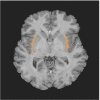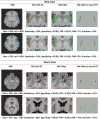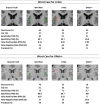AM-UNet: automated mini 3D end-to-end U-net based network for brain claustrum segmentation
- PMID: 35035265
- PMCID: PMC8742670
- DOI: 10.1007/s11042-021-11568-7
AM-UNet: automated mini 3D end-to-end U-net based network for brain claustrum segmentation
Abstract
Recent advances in deep learning (DL) have provided promising solutions to medical image segmentation. Among existing segmentation approaches, the U-Net-based methods have been used widely. However, very few U-Net-based studies have been conducted on automatic segmentation of the human brain claustrum (CL). The CL segmentation is challenging due to its thin, sheet-like structure, heterogeneity of its image modalities and formats, imperfect labels, and data imbalance. We propose an automatic optimized U-Net-based 3D segmentation model, called AM-UNet, designed as an end-to-end process of the pre and post-process techniques and a U-Net model for CL segmentation. It is a lightweight and scalable solution which has achieved the state-of-the-art accuracy for automatic CL segmentation on 3D magnetic resonance images (MRI). On the T1/T2 combined MRI CL dataset, AM-UNet has obtained excellent results, including Dice, Intersection over Union (IoU), and Intraclass Correlation Coefficient (ICC) scores of 82%, 70%, and 90%, respectively. We have conducted the comparative evaluation of AM-UNet with other pre-existing models for segmentation on the MRI CL dataset. As a result, medical experts confirmed the superiority of the proposed AM-UNet model for automatic CL segmentation. The source code and model of the AM-UNet project is publicly available on GitHub: https://github.com/AhmedAlbishri/AM-UNET.
© The Author(s), under exclusive licence to Springer Science+Business Media, LLC, part of Springer Nature 2021.
Figures













Similar articles
-
[Fully Automatic Glioma Segmentation Algorithm of Magnetic Resonance Imaging Based on 3D-UNet With More Global Contextual Feature Extraction: An Improvement on Insufficient Extraction of Global Features].Sichuan Da Xue Xue Bao Yi Xue Ban. 2024 Mar 20;55(2):447-454. doi: 10.12182/20240360208. Sichuan Da Xue Xue Bao Yi Xue Ban. 2024. PMID: 38645864 Free PMC article. Chinese.
-
Optimal Res-UNET architecture with deep supervision for tumor segmentation.Front Med (Lausanne). 2025 May 30;12:1593016. doi: 10.3389/fmed.2025.1593016. eCollection 2025. Front Med (Lausanne). 2025. PMID: 40520778 Free PMC article.
-
Attention-VGG16-UNet: a novel deep learning approach for automatic segmentation of the median nerve in ultrasound images.Quant Imaging Med Surg. 2022 Jun;12(6):3138-3150. doi: 10.21037/qims-21-1074. Quant Imaging Med Surg. 2022. PMID: 35655843 Free PMC article.
-
Attention-UNet architectures with pretrained backbones for multi-class cardiac MR image segmentation.Curr Probl Cardiol. 2024 Jan;49(1 Pt C):102129. doi: 10.1016/j.cpcardiol.2023.102129. Epub 2023 Oct 20. Curr Probl Cardiol. 2024. PMID: 37866419 Review.
-
A ViTUNeT-based model using YOLOv8 for efficient LVNC diagnosis and automatic cleaning of dataset.J Integr Bioinform. 2025 Jun 4. doi: 10.1515/jib-2024-0048. Online ahead of print. J Integr Bioinform. 2025. PMID: 40460443 Review.
Cited by
-
Deep Learning Paradigm and Its Bias for Coronary Artery Wall Segmentation in Intravascular Ultrasound Scans: A Closer Look.J Cardiovasc Dev Dis. 2023 Dec 4;10(12):485. doi: 10.3390/jcdd10120485. J Cardiovasc Dev Dis. 2023. PMID: 38132653 Free PMC article. Review.
-
gamUnet: designing global attention-based CNN architectures for enhanced oral cancer detection and segmentation.Front Med (Lausanne). 2025 Jul 23;12:1582439. doi: 10.3389/fmed.2025.1582439. eCollection 2025. Front Med (Lausanne). 2025. PMID: 40771464 Free PMC article.
-
Deep Learning-Based Segmentation of 3D Volumetric Image and Microstructural Analysis.Sensors (Basel). 2023 Feb 27;23(5):2640. doi: 10.3390/s23052640. Sensors (Basel). 2023. PMID: 36904845 Free PMC article.
-
A comprehensive and reliable protocol for manual segmentation of the human claustrum using high-resolution MRI.Brain Struct Funct. 2025 Aug 13;230(7):134. doi: 10.1007/s00429-025-02993-7. Brain Struct Funct. 2025. PMID: 40801969
References
-
- Alalwan N, Abozeid A, ElHabshy AA, Alzahrani A. Efficient 3d deep learning modelfor medical image semantic segmentation. Alex Eng J. 2021;60(1):1231–1239. doi: 10.1016/j.aej.2020.10.046. - DOI
-
- Albishri A, Shah SJ, Lee Y (2019) Cu-net: cascaded u-net model for automated liver and lesion segmentation and summarization. In: 2019 IEEE international conference on bioinformatics and biomedicine (IEEE BIBM 2019)
-
- Albishri AA, Shah SJH, Schmiedler A, Kang SS, Lee Y (2019) Automated human claustrum segmentation using deep learning technologies. arXiv preprint arXiv:1911.07515
-
- Asperti A, Mastronardo C (2017) The effectiveness of data augmentation for detection of gastrointestinal diseases from endoscopical images. arXiv preprint arXiv:1712.03689
LinkOut - more resources
Full Text Sources
Research Materials
